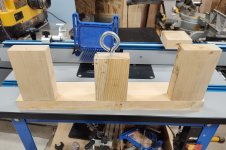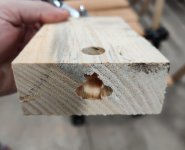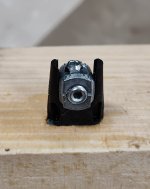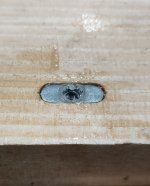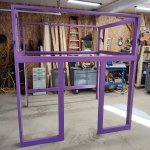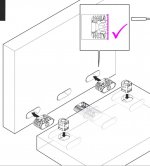We're building a loft bed for our daughter and have a need for knockdown connectors. I only have the DF500 and the 700 isn't really in the budget right now. I knew the EV/32 connectors would be much better suited for holding a bed together, but wanted to know how strong the KV D8 connectors actually were. While there are a ton of videos and info about the strength of a glued Domino joint, I couldn't find anything about the knockdown connectors.
I built a test rig out of the same white pine 2x4s the sides of the frame are made of. I attached three vertical pieces of 2x4 joined to a single long horizontal 2x4 with about 5" of space between them all. One was joined with a KV D8 connector, one with a #10x3 1/8 GRK screwed through the horizontal 2x4 into the vertical, and one with a 2 1/2" Kreg pocket hole screw from the vertical 2x4 into the horizontal 2x4.
I secured the whole assembly to the floor with forks on a front end loader. Then I pulled each vertical piece to failure with a chain fall to an eye bolt in each 2x4, measuring the tension with a crane scale. Surprisingly, the KV D8 failed at a very low amount of force, only 107 pounds before the split connector pulled out. The GRK was next at 430 pounds. The pocket hole screw head pulled through the pocket hole and failed at 535 pounds.
Just for fun, I epoxied the split connector in a new 2x4 and will test that tomorrow after it's cured.
I hope this data helps anyone using these connectors. This was my first time using them. They were extremely easy to install and would work great in light duty applications. I'd skip them for anything structural though.
I built a test rig out of the same white pine 2x4s the sides of the frame are made of. I attached three vertical pieces of 2x4 joined to a single long horizontal 2x4 with about 5" of space between them all. One was joined with a KV D8 connector, one with a #10x3 1/8 GRK screwed through the horizontal 2x4 into the vertical, and one with a 2 1/2" Kreg pocket hole screw from the vertical 2x4 into the horizontal 2x4.
I secured the whole assembly to the floor with forks on a front end loader. Then I pulled each vertical piece to failure with a chain fall to an eye bolt in each 2x4, measuring the tension with a crane scale. Surprisingly, the KV D8 failed at a very low amount of force, only 107 pounds before the split connector pulled out. The GRK was next at 430 pounds. The pocket hole screw head pulled through the pocket hole and failed at 535 pounds.
Just for fun, I epoxied the split connector in a new 2x4 and will test that tomorrow after it's cured.
I hope this data helps anyone using these connectors. This was my first time using them. They were extremely easy to install and would work great in light duty applications. I'd skip them for anything structural though.

